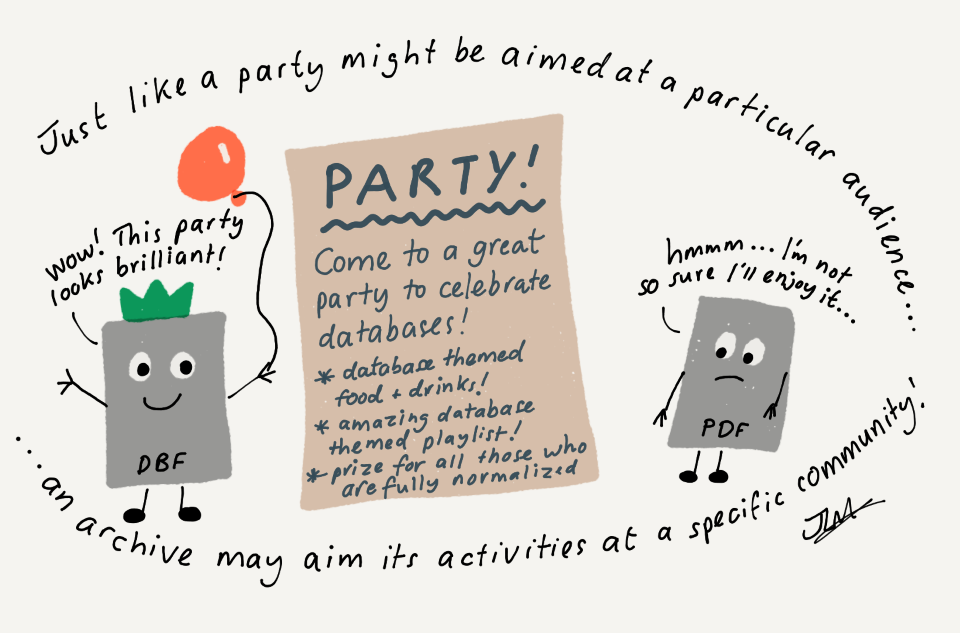Our last DPC event of 2022 was a #DPClinic session on the topic of Designated Communities. The event began with a brief introduction from Herve L’Hours and was followed by a lively and interesting community discussion. Often our #DPClinic topics are generated by the community, but this one was my own idea. I had a particular interest in organizing this session as I had been doing some work on this topic and had some questions in my own mind that I wanted to discuss. I understood the theory of designated communities (which originates from the OAIS Reference Model) but what I really wanted from this session was to understand how this theory translates into practice.
- Is the concept of designated communities something that the digital preservation community actively use in their day to day work?
- Is it an important and necessary concept for them?
- Does everyone have a documented definition that they refer to and update over time, or is it something that a smaller minority engage with, perhaps primarily as a step toward achieving certification?
It was great to have Herve L’Hours to kick off the session with an introduction to the designated communities concept. He described it using an analogy around organizing a party (or indeed a whole series of parties). If he says he is great at organizing parties, would you trust him? You would probably need to ask some questions to find out more about his parties and what they are like - Is there going to be food? Will there be music? Is there a dress code? The answers to these questions might rely on two related questions - who is the party for? and who will actually end up coming? A good party organizer will arrange the party to appeal to a particular set of attendees (the designated community). Not all of those invited will come, and you may also get others that turn up who weren’t on the original invite list (the wider user base), but as long as your party effectively serves your target audience, it is fair to say you have done a good job.

The designated community concept with OAIS is similar. The content that you preserve must be made available to a specific designated community (or multiple designated communities). They should be able to understand it and should meet their needs. A wider set of users might ultimately access the content and gain something from that interaction, but the priority of the archive should be to serve the needs of their designated community.
In a recent reading of OAIS I was surprised to discover the number of times the term ‘designated community’ appears within the standard. It is mentioned so often that there can be no doubt that it is a pretty central concept! This is of course backed up by the fact that defining a designated community is also one of the six mandatory responsibilities of an OAIS. Given this, it might be fair to assume that the vast majority of digital archives have a documented definition of their designated community but a quick poll of the attendees for this session suggest this is not the case at all. Only two attendees raised their hand when asked this question. The majority of those present claimed they did not have a defined designated community. Why this disconnect between the theory and the practice?
There was some discussion about the challenges of defining a designated community for a range of different types of organization - specifically moving beyond the subject or discipline specific archive. Several attendees mentioned their communities would be formed of more than one group, and that at least one of these groups would be very broad. For one attendee it was noted that assuming the broadest definition of community was the best approach - if the richest descriptive information can be gathered, then surely the content can be of the most use to the most people.
Others discussed the complexity that underlies the designated community definition - that in many instances may not consist of a single set of users of a single type of content, but would need to be defined at a much lower level of granularity. For example for a digital archive with a broad collecting remit, would the designated community for geospatial data be entirely different to the designated community for an email archive? It is indeed fair to assume that the users, use cases, knowledge base and familiarity with tools would not be the same and that defining the community at a high level would not be at all useful in informing practice.
Whilst OAIS absolutely allows for multiple communities to make up a designated community, what is perhaps surprising is the lack of examples of how organizations have really addressed this. As I mentioned during the session, I have looked at lots of designated community definitions (specifically those submitted as part of a CoreTrustSeal application) but have not seen any examples of a detailed and granular approach that addresses different content streams, users and their knowledge base separately. This had led me to wonder if for many organizations defining a designated community is seen as a ‘box ticking’ exercise in order to move closer to Trusted Digital Repository certification rather than a task of immediate practical value.
There were also discussions about the challenges of working with a designated community once it has been defined. One attendee noted the difficulties of actually locating users who are consulting born-digital materials to inform user requirements. Another mentioned how hard it is to formulate the right questions to ask users - for example, when working with a broad audience there will be people who don’t actually know what file formats they can work with or even the name of the software that they might use to open a file.
It was noted though that the designated community concept may be helpful in justifying digital preservation activities and potentially in securing resources. Ultimately, the designated community can be a useful concept to cite if challenges or criticisms are received relating to what you are doing or how you are doing it. Being able to explain that you have made certain decisions in order to serve the needs of a specific community of users may be a compelling argument. A recently published study by Rebecca Frank and Laura Rothfritz discusses how the designated community concept may be used to justify sub-optimal processes that may not meet recognised ‘best practice’.
Having a defined and agreed designated community may also be a useful tool in building a case for additional resource. Being able to say that this is your community, this is what they need, and these are the resources that are required in order to meet those needs may be a persuasive argument to use with budget holders.
Some attendees considered the designated communities concept to be an 'under theorized' area of OAIS. Though it seems a helpful concept on paper, examples of how it is used in practice are lacking. Some useful examples are drawn out in the excellent blog post on this topic from David Underdown and Leontien Talboom but they also argue that it represents one of the least developed aspects of the OAIS model, with many archives being unsure how to articulate their Designated Community clearly. Given that we, as a community, have been doing practical digital preservation for many years now, would we not at this stage expect to see a well developed set of examples of documented designated communities with worked case studies of how this has informed digital preservation practice? Does this lack of examples (beyond those from organizations who have sought certification) suggest that few are using the designated community concept in practice? As mentioned by one attendee, does the focus on designated community represent a ‘false trail' serving to divert our attention from other more productive digital preservation activities?
As anticipated, this was an interesting topic for discussion with a range of opinions expressed. It was clear that everyone present accepted the importance of understanding users and their needs (both current and future), but there seemed to be a concern as to whether the theoretical concept of designated community has effectively translated into the practices of those working in the field of digital preservation.
I'm still on the look out for good (detailed, specific, granular) definitions of designated community and examples of how this definition actually informs practice. Do please get in touch if you have a nice example to share!















































































































































